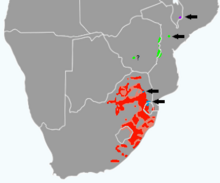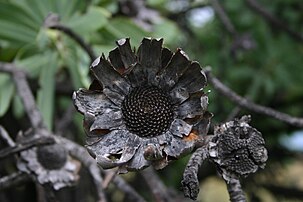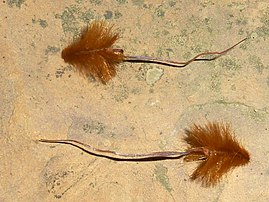Protea afra
| Protea afra | |
|---|---|

| |

| |
| Scientific classification | |
| Kingdom: | Plantae |
| Clade: | Tracheophytes |
| Clade: | Angiosperms |
| Clade: | Eudicots |
| Order: | Proteales |
| Family: | Proteaceae |
| Genus: | Protea |
| Species: | P. afra
|
| Binomial name | |
| Protea afra Meisn. 1856
| |
| Subspecies[2] | |

| |
| Approximate range
P. a. subsp. afra subsp. falcata subsp. gazensis subsp. nyasea | |
| Synonyms[2] | |
| |
Protea afra [ 3 ] (Иногда называется общей протеа ), родом из Южной Африки , представляет собой небольшое дерево или кустарник , который встречается на открытых или лесных лугах , обычно на скалистых хребтах. Его листья кожистые и неровные. Цветочная головка одинока или в кластерах 3 или 4 с инволюционными прицветниками бледно -красного, розового или сливочного цвета. Фрукты - густого волосатого ореха. Вид несколько сильно варьируется и имеет подвидов .
Protea - это цветущего растения род в семействе Proteaceae . Кустарник был впервые обнаружен Фердинандом Краусом в восточных регионах Южной Африки в декабре/январе 1839/40. П. Афра никогда не привлекала особого внимания от садоводства . В мае 1893 года он был вызван цветом в садах Кью , но это не смогло разжечь дальнейший интерес к этому виду. Его главное утверждение о славе заключается в том, что она была проиллюстрирована на обратной стороне южноафриканской монеты под названием « Тикки », эквивалентный британского трипенни , в течение почти 30 лет, пока монета не была отозвана в 1961 году. [ Цитация необходима ]
Описание
[ редактировать ]Upright shrub to small tree 3 – 8m in height with a definite main stem up to 400mm in diameter, crown uneven and spreading. Bark black to dark brown with net-like fissures when mature. Leaves linear-elliptic to linear-falcate, narrow to broadly elliptic, narrow to broadly invert lanceolate, occasionally falcate; 70 – 250mm in length, 4 – 45mm wide, tips blunt to acuminate; smooth, leathery to thin and papery, light green to glaucous green, have a tendency to clump in each year's growth. Flowers carried at the end of leafy twigs 4 – 12mm in diameter, usually singly but up to 4 heads may be grouped at the tip; globose to egg-shaped, broad and shallow when fully open, 45 – 80mm in diameter, base broad convex to flat, 20 – 30mm in diameter. Involucral bracts in 6 – 8 series; outer series broad oval to deltoid, 10 – 20mm wide, 5 – 7mm long, usually with silky silvery pelt of varying thickness at the distal ends but may be hairless, closely and densely shingled; inner series elongated to broadly elongated spatulate, 30 – 50mm long, 10 – 20mm wide, tips rounded to almost acuminate, slightly concave, smooth, varying in color from pale cream to brick red; very variable.
Subspecies
[edit]- P. afra subsp. afra Meisn. — Katberg to Soutpansberg, South Africa, adjacent Lesotho and Eswatini
- P. afra subsp. falcata (Beard) M.Lötter — Limpopo and Mpumalanga escarpment, South Africa[4]
- P. afra subsp. gazensis — eastern Zimbabwe and adjacent Mozambique
- P. afra subsp. kilimandscharica
- P. afra subsp. mafingensis — northern Malawi
- P. afra subsp. nyasea — endemic to Mount Mulanje, southern Malawi
Habitat
[edit]Protea afra subsp. afra is widely distributed across the eastern reaches of South Africa (Gauteng, Kwazulu-Natal, Limpopo, Mpumalanga, the Eastern Cape as far south as the Katberg mountains) and Lesotho.[5] It prefers poor, quartzitic, acidic soils, but is equally at home on a wide variety of well-drained soils and has even been found on alkaline dolomitic soils. It occurs from sea level to 2,100 m, always on southern slopes where the terrain is broken and rocky, or mountainous. It usually forms open stands in which it is the single large shrub or tree; these stands can cover large areas.
Protea afra subsp. gazensis occurs in the Eastern Highlands along the border of Mozambique and Zimbabwe, including the Nyanga Mountains and Chimanimani Mountains, and on Mount Gorongosa in Mozambique. It occurs in grasslands and shrublands from 1,500 to 2,100 meters elevation.[6]
Protea afra is an exceptionally variable species, and seems to be composed of a mosaic of local races that exhibit small differences, usually in the size, colour, texture and shape of the leaves. Where winters are cold and dry the plant has stiff, thick, pale green leaves, while as the distribution moves westwards the leaves become larger, softer, darker and more pliant. The flowers are generally pinkish-red to carmine with green at the base, and are produced during a clearly defined 6 – 8 week period; this period may begin as early as October in coastal regions, and as late as December in higher regions. The flower heads produce a sweet, slightly sulphurous odour that attracts scarab beetles in large numbers. The dense, fissured bark provides the trees with a large measure of fire resistance. The bark can be used medicinally.
Cultivation
[edit]A very hardy perennial shrub that will survive temperatures of at least −5 degrees Celsius. The seeds will germinate in the summer 22 days after planting, and the young plants will reach a height of 10 cm in their first year. Thereafter, growth can be somewhat variable with stops and starts. Should start to bloom from the 6th year, when lower branches should be pruned to stimulate the flowering shoots.
Gallery
[edit]-
P. afra woodland
-
Flowerhead in bud
-
Old flower discs
-
Seeds in winter
Ссылки
[ редактировать ]- ^ Rebelo, Ag; Раймондо Д. (2020). « Протея Каффра » . МСОП красный список угрожаемых видов . 2020 : E.T113208842A185531182. doi : 10.2305/iucn.uk.2020-3.rlts.t113208842a185531182.en . Получено 18 ноября 2021 года .
- ^ Подпрыгнуть до: а беременный "Protea afra Meisn. | Растения мира онлайн | Kew Science" .
- ^ Каллавей, Эвен (2024). «Сотни имен расистских заводов изменится после исторического голосования ботаниками» . Природа . doi : 10.1038/d41586-024-02365-x . PMID 39026072 . Архивировано из оригинала 8 августа 2024 года . Получено 8 августа 2024 года .
- ^ Rebelo, Ag; Mtshali, H.; Lötter, M.; Берроуз, JE (2020). «Серп-лиянный сахар» . Национальная оценка: красный список южноафриканских растений . Redlist.sanbi.org. Архивировано из оригинала 24 апреля 2024 года . Получено 24 апреля 2024 года .
- ^ « Протея Каффра » . Plantzafrica.com . Архивировано с оригинала 24 сентября 2015 года . Получено 11 августа 2015 года .
- ^ «Информация о видах: protea caffra subsp. Gazensis». Флора Зимбабве . 11 апреля Доступ 2020 . года
Источники
[ редактировать ]- Ван Вик, Б. и Ван Вик, П. 1997. Полевое руководство по деревьям Южной Африки . Струк, Кейптаун
- Пули, Э. 2005. Полевое руководство по полевым цветам Квазулу-Натала и Восточного региона . Национальный фонд цветочных публикаций, Дурбан
- Рурк, JP 1980. Протеи южной Африки Тафельберг, Кейптаун
- Roussouw, F. 1970. Proteaceae Южной Африки Пурнелл, Кейптаун
Внешние ссылки
[ редактировать ] СМИ, связанные с Protea afra в Wikimedia Commons
СМИ, связанные с Protea afra в Wikimedia Commons




